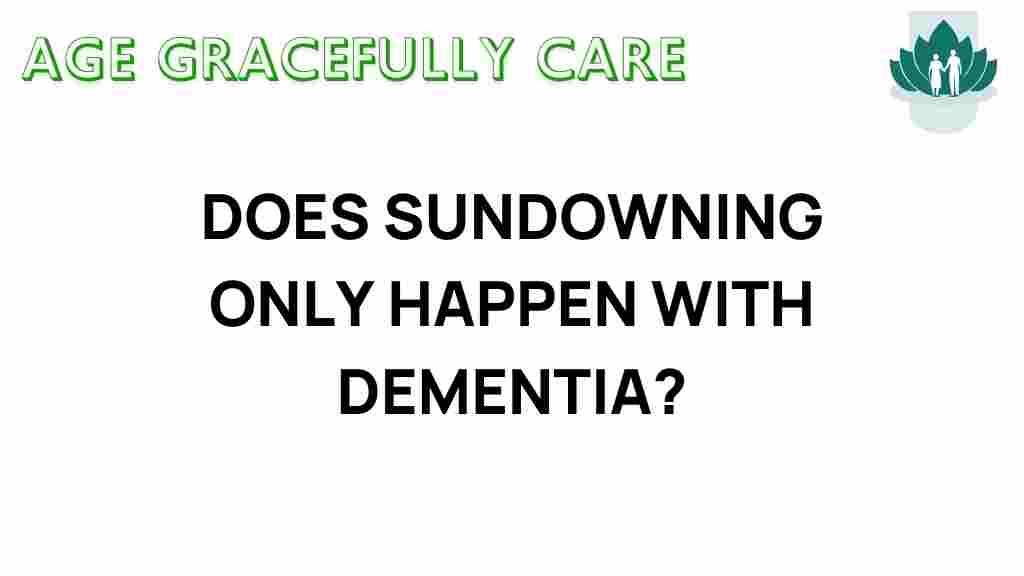Sundowning: Understanding Its Connection with Dementia
Sundowning is a term that refers to a phenomenon where individuals with cognitive decline experience increased confusion, agitation, and behavioral symptoms during the late afternoon and evening. This condition is particularly prevalent among the elderly, especially those diagnosed with dementia, including Alzheimer’s disease. Understanding sundowning is essential for caregivers, as it significantly impacts the mental health of both the individual experiencing it and those providing elderly care.
What Is Sundowning?
Sundowning is characterized by a pattern of increased anxiety, confusion, and irritability that occurs in the late afternoon or early evening. The symptoms can range from mild to severe and often lead to nighttime agitation. While sundowning is most commonly associated with dementia, it can also occur in individuals without a formal dementia diagnosis.
Understanding the Connection to Dementia
Dementia is an umbrella term that encompasses a variety of cognitive disorders, including Alzheimer’s disease. Individuals with dementia may experience sundowning due to a combination of factors:
- Cognitive Decline: As the brain’s function deteriorates, individuals may struggle to process information, leading to confusion and anxiety.
- Fatigue: As the day progresses, many individuals become tired, which can exacerbate cognitive difficulties and lead to increased agitation.
- Environmental Changes: The transition from day to night can create confusion, as changes in lighting and shadows may be misinterpreted by individuals with cognitive impairments.
Common Behavioral Symptoms of Sundowning
Behavioral symptoms associated with sundowning can vary widely among individuals but often include:
- Increased confusion as evening approaches
- Restlessness and pacing
- Agitation and irritability
- Verbal outbursts or yelling
- Wandering or attempting to leave the home
- Difficulty settling down for bed
Is Sundowning Exclusive to Dementia?
While sundowning is most commonly linked to dementia, it is not exclusive to this condition. Other factors can contribute to nighttime agitation in the elderly, including:
- Other Medical Conditions: Conditions such as Parkinson’s disease, depression, or anxiety can also lead to similar symptoms.
- Medications: Some medications can cause side effects that may contribute to confusion or agitation, particularly if taken in the evening.
- Environmental Factors: Noise, temperature changes, or other disruptions can impact an individual’s sense of security and comfort.
Recognizing Sundowning in Non-Dementia Patients
Caregivers should be alert to signs of sundowning in individuals without dementia. These may include:
- Increased anxiety or restlessness during the evening
- Changes in sleep patterns or insomnia
- Difficulty with orientation, such as confusion about time or place
Strategies for Managing Sundowning
Managing sundowning involves a combination of environmental adjustments, routine establishment, and caregiver support. Here’s a step-by-step process to help mitigate the effects of sundowning:
1. Establish a Consistent Routine
Keeping a regular daily schedule can help reduce confusion. Here are some key points to consider:
- Set consistent meal, activity, and bedtime schedules.
- Engage in calming activities in the evening, such as reading or listening to soothing music.
- Avoid stimulating activities late in the day.
2. Optimize the Environment
Creating a calming environment can help ease nighttime agitation:
- Ensure the home is well-lit to reduce shadows and confusion.
- Minimize noise and distractions that may cause anxiety.
- Consider using night lights to improve visibility during the evening.
3. Monitor Physical Health
Physical health plays a significant role in mental well-being. Consider the following:
- Ensure regular medical check-ups to address any underlying health issues.
- Review medications with a healthcare professional to identify any that may exacerbate symptoms.
4. Encourage Physical Activity
Regular physical activity can help reduce anxiety and improve sleep quality:
- Encourage light exercises during the day, such as walking or stretching.
- Avoid vigorous activity close to bedtime.
5. Provide Caregiver Support
Caregivers play a crucial role in managing sundowning. Support for caregivers can include:
- Regular breaks to prevent burnout.
- Access to support groups or counseling services.
- Education on dementia and sundowning to better understand the condition.
Troubleshooting Tips for Caregivers
If you are a caregiver managing an individual experiencing sundowning, consider these troubleshooting tips:
- Stay Calm: Remain calm and composed during episodes of agitation. Your demeanor can influence the individual’s reaction.
- Redirect Attention: Use distraction techniques to shift focus from anxiety or agitation to a more calming activity.
- Involve Professional Help: If sundowning symptoms worsen, consult a healthcare professional for further evaluation and guidance.
Conclusion: Understanding and Managing Sundowning
Sundowning can be a challenging aspect of caring for individuals with dementia, particularly as it often leads to heightened behavioral symptoms and nighttime agitation. While it is most commonly associated with cognitive decline, sundowning can occur in non-dementia patients as well. By understanding the triggers and implementing effective strategies, caregivers can create a supportive environment that mitigates the effects of sundowning.
It is crucial for caregivers to prioritize their mental health and seek support when needed. Resources are available, including community support groups and professional counseling, which can provide invaluable assistance in managing the emotional and physical toll of caregiving. For more information on caregiver support, visit Caregiver Support Network.
Understanding sundowning is a vital step in improving the quality of life for both the elderly individual and their caregivers. By creating a structured, calming environment and providing compassionate support, we can help those affected navigate the challenges of cognitive decline with dignity and care.
For further reading on dementia-related behavioral symptoms and strategies for care, check out this informative article on Dementia Care Strategies.
This article is in the category Health and created by AgeGracefullyCare Team
